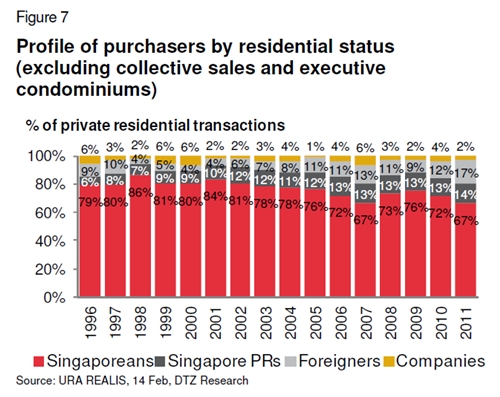yes, it's funny, Ministry of National Development announced the "new measures" more than 1 year ago in mar 2011 but till now most showflats are still NOT complying with the new rules. So who is going to inspect to check that the measures are complied with, and by when will it happen?
Something done by ALL developers is remove walls in showflats...it made the showflat looks much bigger and spacious than if the walls remain. Another thing commonly done is to have custom made furniture and carpentry, to maximise usage of the limited space. Othewise, how can they sell 3 bedroom condos with floor area of 635 sf?
Cheers!
Dennis Ng
The Straits Times
Apr 9, 2012
Random check: Showflats don't fulfil proposed criteria
Market watchers say new guidelines should be implemented soon
By Gan Yu Jia
A RECENT Straits Times check on six showflats has revealed that all fell short of some of the rules proposed in March last year to ensure that developers are more transparent in their marketing.
The observation comes amid record monthly sales of 3,138 new homes logged in February, some of which were small-sized 'shoebox' units.
The guidelines were aimed at giving buyers a more accurate picture of what it would feel like to live in the flats. Almost all buyers who snap up new homes would have stepped into a showflat before making the decision to buy.
The refusal to adhere to guidelines may have meant that buyers could have left these flats in some confusion as to how big the actual unit would be and if walls or doors had been removed to give the impression of more living space.
Property investor David Lee said: '(Developers) make the inside look very grand... with nice wallpaper and furniture. Certain walls they knock down.'
That was certainly the impression gleaned from the checks made on the six showflats, which were randomly selected from across the island: two in the west, two in the east, and two in the central districts and all from different developers.
Three of the proposed rules were not observed by any of the six flats.
These were requirements that there be signs to mark any removed walls, partitions or doors; that the location, site and floor plans be drawn to scale; and that the floor areas of exterior spaces like balconies be disclosed.
There were other guidelines which The Straits Times could not evaluate with certainty, such as ensuring the showflat was of the exact same floor area and the same floor-to-ceiling height as the actual unit.
Market watchers say these results indicate that the new rules are necessary and should be enforced soon.
The proposed new rules aim to prevent misleading marketing gimmicks, to make it easier for buyers to access information about units and to ensure that showflats accurately represent the finished units.
They have undergone consultation with industry players and are 'being finalised' for implementation 'in the second half of the year after the Housing Developers (Control & Licensing) Act has been amended', the Urban Redevelopment Authority (URA) said last Tuesday.
Mr Colin Tan, research head at Chesterton Suntec International, said the new rules will help overcome some 'illusionary effects' of showflats, such as 'when beds are custom-made (to be) smaller or when walls are removed or replaced by transparent glass panels'.
He suggested that developers could prepare a bare showflat unit, 'the condition in which the developer will actually deliver the unit to you', and another showflat with a designed interior, 'to show what buyers can do to make it feel more spacious'.
International Property Advisor chief executive Ku Swee Yong noted that the suggestion to inform buyers about the sizes of exterior areas like aircon ledges and balconies, which are considered less useable spaces, was especially pertinent given that 'small-sized residential units suffer from disproportionately large low-value floor areas'.
'For a luxury 2,000 sq ft apartment, such areas may take up 8 to 15 per cent of the (space), but for small apartments of 500 sq ft, such low-value areas may take up more than 20 to 30 per cent,' he said.
'Given the proliferation of small-sized units in Singapore, I believe we should implement these guidelines urgently.'
Developers say they are all for transparency but were quick to stress that measures were taken to ensure their showflats were modelled after actual units.
A Keppel Land spokesman said buyers often asked if the showflat fittings and finishes and the unit's specifications would be similar to the end product.
'Where there are any disparities due to interior design styling, notices will be displayed at prominent locations informing buyers,' she added.
Others said that some of the unfulfilled requirements in the showflats checked could be verbally communicated to visitors or were just plain obvious.
Tuan Sing chief financial officer Chong Chou Yuen said of the suggestion to put signs at places where doors have been removed: 'Removed doors are understood, so to me it's not necessary... but if (the URA) eventually decides to implement these things, we have no issue.
'As far as we can see, we have complied with the spirit of the guidelines.'
However, Propnex chief executive Mohamed Ismail noted that there were constraints as to how accurate showflats could be.
'You can't have a design for every model. You may have six different designs... and each room may have a different layout depending on which part of the building. A showflat will only choose a sample of the building,' he said.
yjgan@sph.com.sg
